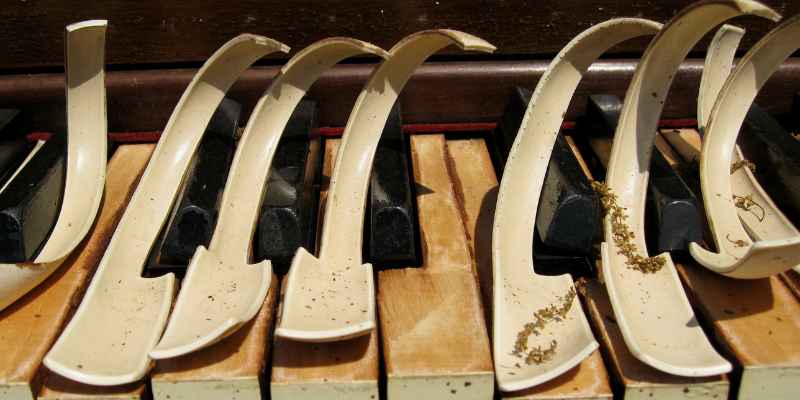To warp wood with water, soak the wood in hot water for several hours. Once saturated, bend the wood into the desired shape and secure it until it dries.
Warping wood with water is a traditional technique widely used in woodworking. This method allows you to create curved shapes and intricate designs that would otherwise be difficult to achieve. Many craftsmen and hobbyists appreciate this process for its simplicity and effectiveness.
By using water, you can manipulate the wood fibers, making them more pliable. The technique works best with softwoods like pine and cedar. Understanding the proper soaking time and drying methods can enhance your results. Whether for furniture making or artistic projects, mastering this skill can elevate your woodworking game significantly.
The Science Of Wood Warping
Wood warping happens due to moisture changes. The way wood absorbs water affects its shape. Temperature and humidity also play big roles.
Different types of wood react differently. Softwoods like pine warp easily. Hardwoods like oak are more stable.
| Type of Warp | Description |
|---|---|
| Bow | Wood bends along its length. |
| Cup | Edges rise while the center sinks. |
| Twist | Wood twists along its grain. |
| Split | Wood cracks, often from drying too fast. |

Identifying Wood Prone To Warping
Choosing the right wood is key for successful water warping. Certain woods are more sensitive to warping than others. Common warp-sensitive wood types include:
| Wood Type | Characteristics |
|---|---|
| Oak | Can easily warp in wet conditions. |
| Pine | Softwood that bends easily. |
| Maple | Strong but can twist under moisture. |
| Cherry | Prone to warping with humidity changes. |
Look for wood with high moisture content. This wood will respond better to water warping techniques. Avoid dense or heavy woods for this process. They resist moisture absorption and warping.
Preparation For Warping Wood
Before starting, ensure proper safety measures are in place. Always wear gloves and goggles. This protects against splinters and moisture.
Gather the right tools and materials for warping wood. Here’s a simple list:
| Tools | Materials |
|---|---|
| Hose or spray bottle | Wood piece |
| Plastic sheet | Water |
| Clamps |
Ensure all items are clean and ready for use. Check for any damage on tools. Safe preparation leads to successful results.
The Soaking Process
To effectively warp wood, start by submerging it correctly. Place the wood in a large container filled with warm water. Ensure the wood is completely underwater to absorb moisture evenly.
Monitor the duration of soaking. Generally, wood should soak for at least 30 minutes. Thicker pieces may need up to 24 hours. Check the wood periodically to ensure it does not become overly saturated.
After soaking, remove the wood and allow it to drip dry. This helps avoid excess moisture, which can lead to damage. Always remember, proper soaking is key to successful wood warping.
Manipulating Wood Shape
Wood can be shaped easily with water. Many techniques help in bending wood. Steam bending is a popular method. This process uses hot steam to soften the wood fibers. Another technique is soaking the wood in water. Soaking makes the wood flexible.
Using a form helps maintain the desired shape. The wood should be clamped to the form. Keep it in place until it dries. Drying time can vary based on wood type. The thicker the wood, the longer it takes to dry.
Always remember to wear protective gear. Safety is important while working with wood. Experiment with different types of wood for best results.
Drying And Setting The Warp
Choosing the right environment is key for drying wood. Keep the wood in a well-ventilated area. Avoid direct sunlight to prevent cracking. A consistent temperature helps in even drying. Humidity levels should be moderate, ideally between 30% and 50%.
Setting the warp takes time. Generally, allow 24 to 48 hours for minor adjustments. For larger warps, extend the time to several days. Check the wood regularly to ensure it is drying evenly. Using weights can help maintain the desired shape.
Finishing Warped Wood
Sanding helps make warped wood smooth. Use medium-grit sandpaper first. Follow this with fine-grit sandpaper for a better finish. Sand in the direction of the grain. This prevents scratches and damage.
Sealing wood protects it from moisture. Apply a good wood sealer after sanding. This helps keep the wood safe from warping again. Choose a sealer that fits your wood type. Wait for the sealer to dry completely before using the wood.
Protecting wood is very important. Use a coat of varnish or polyurethane. This adds an extra layer of protection. Regular maintenance keeps your wood looking great.
Applications And Projects
Warped wood can create amazing art pieces. Many artists use it for sculptures. The unique shapes bring a natural look to any space.
Furniture makers enjoy using warped wood for tables and chairs. The curves add character and charm. Items like shelves and frames also benefit from this technique.
Craftspeople make decorative wall hangings from warped wood. They use vibrant paints to highlight the curves. This creates beautiful home decor.
Musicians appreciate warped wood for instruments. It enhances the sound quality. Guitars and violins often use this technique.
| Project Type | Description |
|---|---|
| Sculptures | Art pieces with unique shapes |
| Furniture | Chairs and tables with character |
| Wall Hangings | Decorative pieces for homes |
| Musical Instruments | Enhanced sound quality |
Troubleshooting Common Issues
Over-warping can happen if wood absorbs too much water. To fix this, gently apply heat using a heat gun. Keep the wood on a flat surface. Place weights on the wood to keep it straight while it cools.
Cracks and splits in wood can be fixed easily. First, clean the area around the crack. Use wood glue to fill in the crack. Clamp the wood until the glue dries. Sand the area smooth for a better finish.
Maintenance And Care Of Warped Wood
To ensure long-term preservation of warped wood, proper care is essential. Keep the wood in a dry environment. Excess moisture can cause further warping.
Regularly clean the wood to remove dust and dirt. Use a soft cloth or a gentle brush. Avoid using harsh chemicals that can damage the surface.
Handle warped wood with care. Lift it gently to prevent cracks. Store it in a stable location, away from direct sunlight or heat sources.
Consider applying a protective finish to enhance durability. This can help prevent future damage. Regular inspections can also catch issues early.

Frequently Asked Questions
How Does Water Warp Wood?
Water warps wood by causing it to absorb moisture. When wood absorbs water, its fibers swell and expand. This uneven expansion can lead to bending or twisting. The process is most effective on softer woods. Proper techniques can help control the warping process for desired shapes.
What Types Of Wood Can Be Warped?
Most softwoods, like pine and cedar, are suitable for warping. Hardwoods can also be warped, but they require more water and time. Experimenting with different types can yield interesting results. Consider your project’s needs when choosing wood. Each wood type responds uniquely to water application.
How Long Does It Take To Warp Wood?
The time to warp wood varies based on several factors. Typically, it can take anywhere from a few hours to several days. Factors include wood thickness, water temperature, and humidity levels. Monitor the wood regularly for desired bending. Patience is key to achieving the best results.
Can I Warp Wood Without Boiling?
Yes, you can warp wood without boiling. Soaking wood in hot water is an effective alternative. Steam bending is another method that doesn’t require boiling. Both methods allow for controlled warping. Choose the method that best fits your project and available resources.
Conclusion
Warping wood with water is a simple yet effective technique. It allows for creative designs and enhances woodworking projects. By following the steps outlined, you can achieve great results. Embrace this method and unlock new possibilities in your woodworking endeavors.
Happy crafting, and may your creations be both beautiful and functional!

